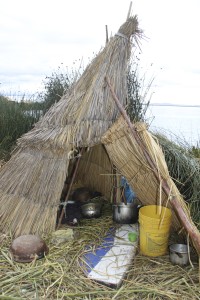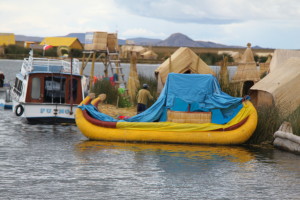Dec. 11/12 – What a unique tour! I thought no lifestyle can be simpler than what I saw in the jungle in Bolivia last week until I visited the people living on these floating islands in Peru today.
Our first stop in Peru was Puno. Here, we joined a tour to see how the people lived on “floating homes” located inside the bay of Lake Titicaca only 14 km (9 miles) away from the city (20 – 30 min boat ride). People living on these homes are called Uros and their houses are simple.
Their homes are really floating on the lake and a group of floating homes is called “floating islands.” Because of this condition, services for them are very basic. They do not enjoy potable water, no electricity, no modern bathrooms and shower areas.
Despite the modernity around them, the Uros continue to live as their ancestors did: using totora reeds to build their homes, boats and rafts; they survive through fishing, weaving and at present, tourism as a result of their place becoming a tourist spot. They also catch shore birds and ducks for food. When the water level of the lake is low, they have the opportunity to plant potatoes on soil that is not “real” soil but decayed totora reeds. However, they are not really agricultural people.
Apart from this, Uros still wear layers of clothing as protection from the elements – cold, wind and sun that may burn them seriously. Uros women still wear that derby-type hat and full skirts.
The Uros may now be “exposed” to peoples to other cultures but despite this, they still kept to themselves.
The size of the entire “floating islands” do change depending on how many homes are needed to be built. The islands are uneven and the flooring is not stable; it’s like walking on waterbed that one can’t get a solid balance while walking. One step on the wrong area may cause a leg to sink into the waters!
It is this condition that makes it difficult for the Uros to “maintain” their island. The totora reeds get rotten because of the water or they break up because of dryness. Whatever the case may be, the Uros need to strengthen their homes or their rafts by adding new layers to them. Keeping up with the demands of tourism make the task more challenging. Tourism is a welcome thing as this provides financial support. At the same time though, it challenges the lifestyle they are used to and the culture they have carried on for years.
Originally posted on Amy’s travel blog: TravelwithAmy.ca






